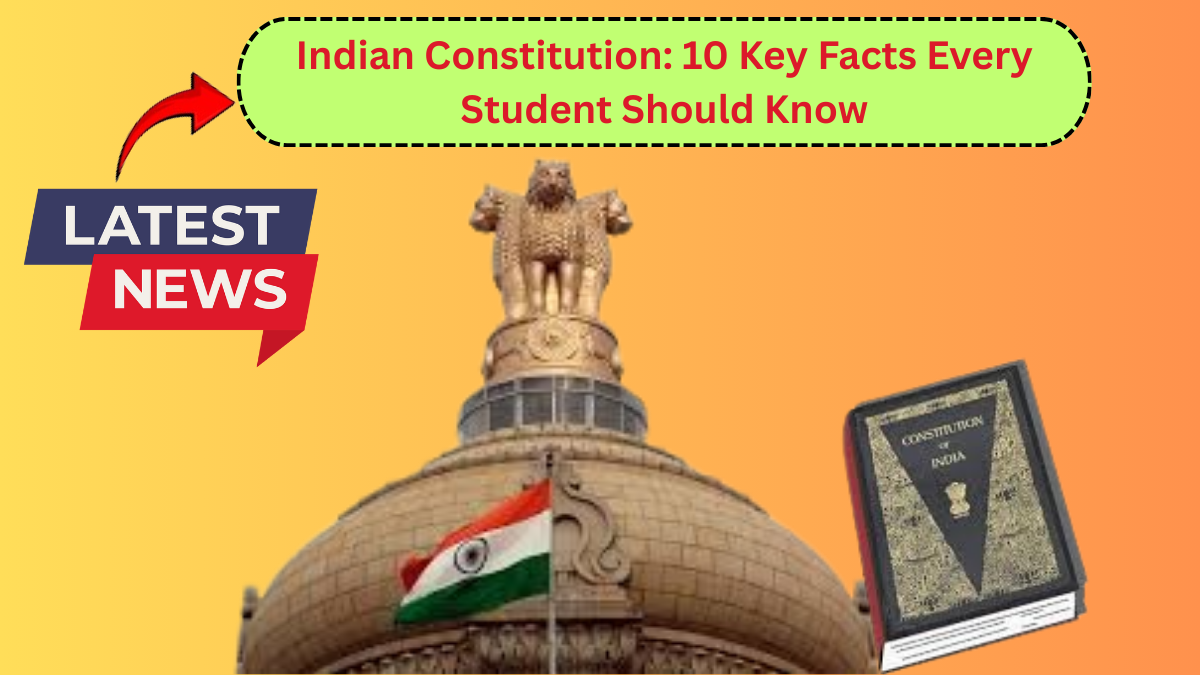Understanding the Indian Constitution key facts is essential for every student. It’s not just a legal document—it’s the backbone of Indian democracy, shaping how the country functions and how its citizens live. Whether you’re preparing for a civics exam, competitive tests, or just want to understand your rights and duties, this guide breaks down the ten most critical aspects of the Indian Constitution in a simple yet comprehensive way.

1. The Longest Written Constitution in the World
India holds the distinction of having the longest written constitution globally. Adopted on January 26, 1950, the document originally contained 395 articles in 22 parts and 8 schedules. Today, after numerous amendments, it includes over 470 articles divided into 25 parts and 12 schedules. This level of detail ensures clarity in governance for a nation as diverse and complex as India.
2. Borrowed but Unique Framework
While the Indian Constitution is original in spirit, it has drawn inspiration from other countries. For instance, the parliamentary system is taken from the UK, fundamental rights from the US, directive principles from Ireland, and federal structure from Canada. However, India customized these elements to suit its unique social, cultural, and historical context—making it a tailor-made blueprint for Indian democracy.
3. The Preamble: The Soul of the Constitution
The Preamble acts as the guiding light of the Constitution. It declares India to be a Sovereign, Socialist, Secular, Democratic Republic. It also ensures Justice, Liberty, Equality, and Fraternity for all citizens. Though not legally enforceable, the Preamble is frequently used by courts to interpret ambiguous constitutional provisions.
4. Fundamental Rights: The Core of Citizen Protection
Among the most powerful Indian Constitution key facts is the inclusion of fundamental rights in Part III. These rights include:
Right to Equality
Right to Freedom
Right against Exploitation
Right to Freedom of Religion
Cultural and Educational Rights
Right to Constitutional Remedies
These rights are enforceable by courts and are essential for maintaining justice and dignity in Indian democracy.
5. Directive Principles of State Policy (DPSPs)
Listed in Part IV, DPSPs guide the government in policy-making. Though not legally enforceable, they reflect the ideals of economic and social democracy. Examples include equal pay for equal work, promotion of education, and the right to work. The aim is to ensure a welfare state, even if it takes time to implement.
6. Amendability: Flexibility with Stability
The Indian Constitution balances flexibility and rigidity through its amendment procedure under Article 368. Some provisions require a simple majority in Parliament, while others need a two-thirds majority and ratification by half of the states. This dual process keeps the document dynamic while protecting its core structure.
7. Separation of Powers and Checks and Balances
The Indian Constitution outlines a clear separation between the legislature, executive, and judiciary. This separation ensures that no branch exceeds its authority. The judiciary, especially the Supreme Court, has the power to strike down laws that violate the Constitution—reinforcing the rule of law.
8. Single Citizenship
Unlike federal countries like the USA where people hold dual citizenship (state and national), India offers single citizenship to promote national unity. Every Indian, regardless of their state of residence, is an equal citizen of the country.
9. Universal Adult Franchise
Every Indian citizen aged 18 and above has the right to vote, regardless of caste, religion, gender, or economic status. This ensures that the people directly participate in the Indian democracy, shaping leadership and national policy through elections.
10. Emergency Provisions: Safeguarding National Integrity
The Constitution includes provisions for National, State, and Financial Emergencies. While they give the central government sweeping powers during crises, these provisions also come with strict legal and time-based checks. Notably, India has declared a National Emergency three times—in 1962, 1971, and 1975.
FAQs
What is the importance of knowing Indian Constitution key facts?
Understanding the Constitution helps students become informed citizens. It explains how government functions and clarifies individual rights and responsibilities in a democratic society.
How many fundamental rights are there in the Indian Constitution?
There are six fundamental rights, which include the right to equality, freedom, exploitation, religion, cultural and educational rights, and constitutional remedies.
What makes the Indian Constitution unique?
Its detailed structure, adaptability, inclusion of fundamental rights, and blend of global best practices make it one of the most inclusive and effective constitutions in the world.
How does the Constitution support Indian democracy?
It establishes the framework for free elections, separation of powers, judicial independence, and protection of individual rights, making Indian democracy resilient and people-driven.
click here to learn more